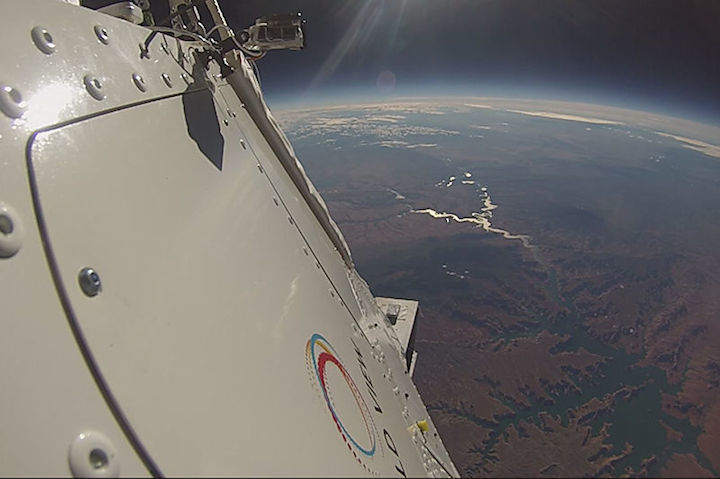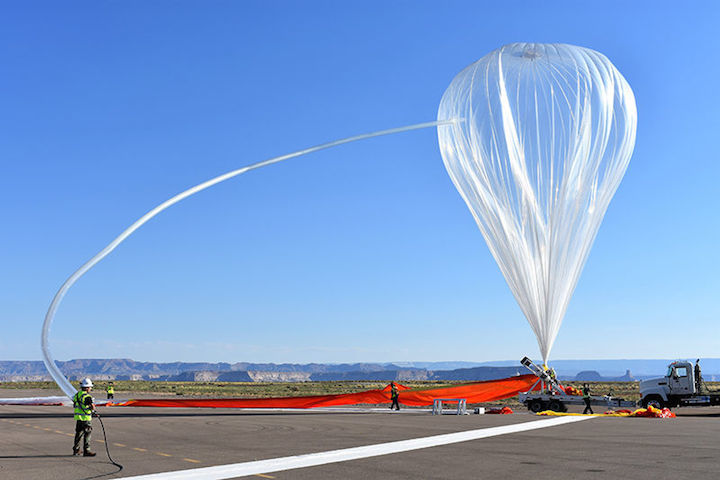5.01.2018
Commercial providers open the market for new types of research flight.

The payload of a World View balloon hovers more than 20 kilometres over Arizona.CREDIT: World View
-
Private companies want to take scientific experiments sky-high in 2018 — aboard high-altitude balloons.
For decades, agencies including NASA and France’s National Centre for Space Studies have flown balloon-borne experiments to realms higher than aeroplanes can reach but lower than satellites’ orbits. Now, companies such as World View of Tucson, Arizona, are lofting payloads quickly and cheaply into the stratosphere, between 16 and 30 kilometres up. The commercial balloon flights have new capabilities that open up fresh types of science — such as low-cost monitoring of natural disasters, or testing how to explore Venus by studying Earth’s geology, says Alan Stern, a planetary scientist at the Southwest Research Institute in Boulder, Colorado, and a co-founder of World View.
“We’re turning what was rare scientific ballooning into something routine,” Stern says.
Balloons occupy a sweet spot between planes, which can survey small areas of land in great detail, and satellites, which span the globe but provide images at much lower resolutions. “We need observations from balloons, because they’re just so powerful,” said Karl Hibbitts, a planetary scientist at the Johns Hopkins University Applied Physics Laboratory in Laurel, Maryland. He spoke at a meeting of the Next-Generation Suborbital Researchers Conference in Broomfield, Colorado, on 18–20 December.
Among the ballooning companies that accept scientific payloads are Raven Aerostar of Sioux Falls, South Dakota, and Near Space Corporation of Tillamook, Oregon. World View has made a splash in the past year by developing a standardized ‘Stratollite’ platform that dangles beneath its balloons. A payload that might cost more than US$1 million to fly on a NASA balloon could fly for as little as tens of thousands of dollars on World View if it shares a Stratollite with other experiments, Stern says.
Flying high
In 2018, World View aims to fly up to four times a month, says Jane Poynter, the company's chief executive. Each balloon would lift one Stratollite carrying one or more experiments into the stratosphere. The longest flight so far lasted just over five days, but Poynter says the company hopes to conduct weeks-long flights in the near future.
Robert Grimm, a planetary scientist at the Southwest Research Institute, flew an experiment on a World View balloon in October to test designs for a possible mission to Venus. The planet's surface is too hot for equipment to survive for long, but conditions high in Venus's atmosphere are much more temperate — meaning that scientists could use balloons as a way to study the planet for months, rather than minutes or hours
From its take-off in Idaho, the balloon soared for 500 kilometres before touching down in Montana. Like a high-flying metal detector, Grimm’s on-board equipment measured changes in electrical properties within a granite-rich mountain range below. Collecting such measurements over Venus could illuminate the geology at or beneath the planet’s surface, says Grimm, who hopes to fly further experiments in May.
World View has also developed ways to hold its balloons nearly stationary over a point of interest. The company directs the balloon up and down to catch the wind and keep the craft in approximately the same location. Alphabet’s Project Loon balloons, which are built by Raven Aerostar, use a similar approach to stay in one spot. The company has been testing the balloons' ability to provide Internet connectivity in places such as Puerto Rico, following last September’s devastating Hurricane Maria.

A Stratollite balloon made by World View is inflated in Page, Arizona.CREDIT: World View
-
Long view
NASA is developing advanced balloon technology for scientists, including its ‘super-pressure’ balloons that can fly for up to 100 days — a period suitable for long-term studies such as certain astronomical observations. But the work is expensive and technologically challenging. For many experiments, “the World View flights are actually there”, says Thomas Zurbuchen, NASA’s associate administrator for science in Washington DC. “We’re really interested in doing some science on these new platforms.” (The agency funded Grimm’s World View flight.)
To Adrienne Dove, a planetary scientist at the University of Central Florida in Orlando, stratospheric balloons offer a new opportunity to explore the physics behind spaceflight. She studies how dust clumps together in low-gravity conditions — important for lunar and planetary exploration — and has worked with sounding rockets and the ‘vomit comet’ aeroplanes that create low gravity for short periods during their parabolic flights. “My interest is in developing microgravity capability on balloons, which currently doesn’t exist,” she says.
Looking even further into the future is Siddharth Krishnamoorthy, an aerospace engineer at the Jet Propulsion Laboratory in Pasadena, California. His team wants to use stratospheric balloons to listen for low-frequency infrasound signals coming from earthquakes, as a test for possible future missions to probe for seismic activity on Venus.
That would mean floating in the stratosphere above earthquake-prone places such as Oklahoma or California, listening for infrasound signals and pretending they are on Venus. “Yes, it’s cool,” says Krishnamoorthy.
Quelle: nature
